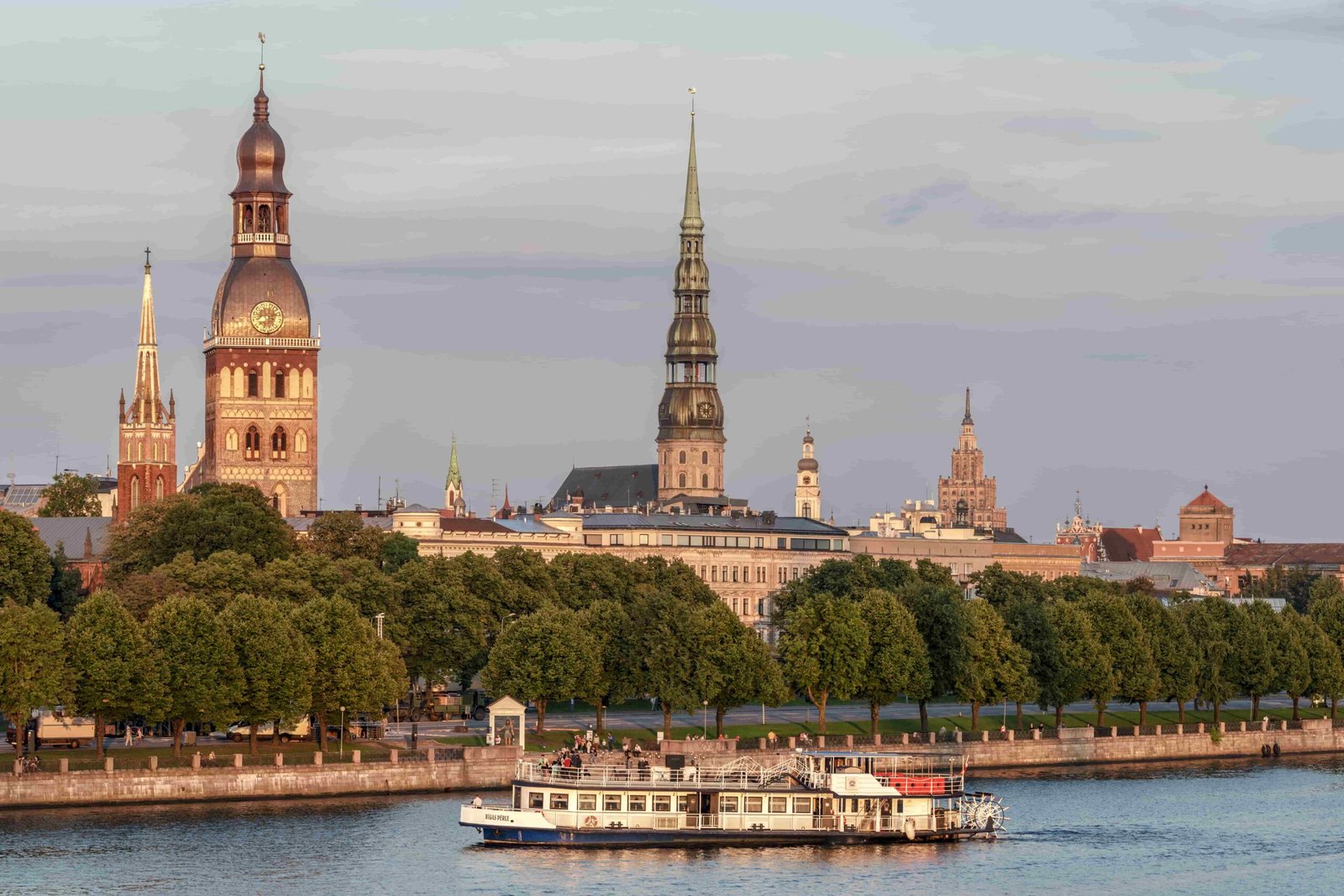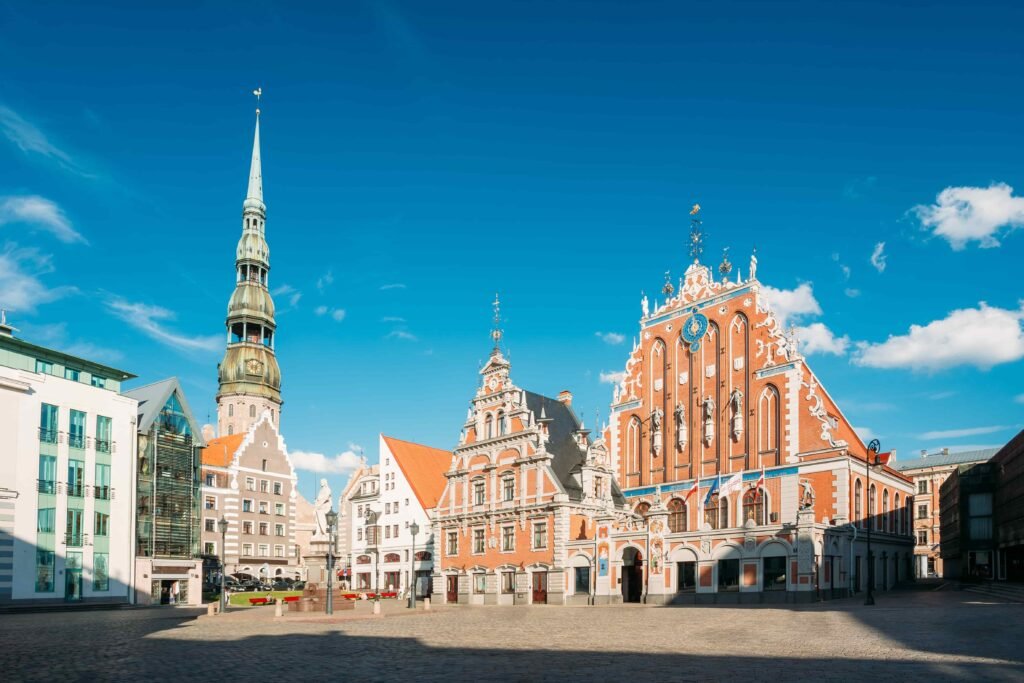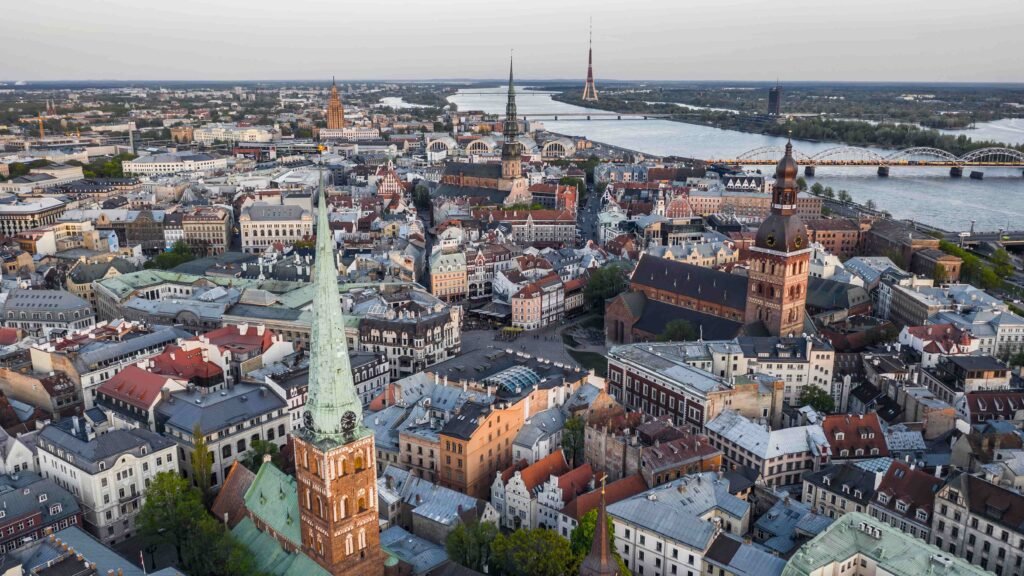
Riga’s Old Town is a charming maze of medieval streets, squares, and alleyways that showcases well-preserved medieval architecture and narrow cobbled streets at every corner. Located in the historical and geographical center of the Latvian capital, Riga old town is a popular entertainment district featuring an abundance of architectural gems and cobblestone streets. It is a must-visit destination for travellers from all over the world.
Founded in 1201 as a port town, Riga was one of the key centers of the Hanseatic League in Eastern Europe from the 13th to the 15th century. The urban fabric of its medieval core reflects the prosperity of those times, though most of the earliest buildings were rebuilt for actual needs or lost by fire or war. As a result, Old Town Riga is a unique blend of architectural styles, including Gothic, Baroque, and Art Nouveau, that reflects the city’s rich history and cultural heritage. The area is so well-preserved that it was designated a UNESCO World Heritage Site in 1997.
Historical Overview
Riga’s Old Town is a UNESCO World Heritage site, and it is one of the most popular tourist destinations in Latvia. The Old Town is famous for its medieval architecture, including the Riga Cathedral, Riga Castle, and the many merchant homes and warehouses. The city’s history is associated with Germanic and Christian cultures, and it has a rich and fascinating past.
Medieval Beginnings
Riga was founded in 1201 by Bishop Albert, and it was granted city status in 1225. During the 13th to the 15th century, Riga was one of the key centres of the Hanseatic League in Eastern Europe. The urban fabric of its medieval core reflects the prosperity of those times, though most of the earliest buildings were rebuilt for actual needs or lost by fire or war. The city’s medieval past is still evident in the narrow streets, Gothic architecture, and the many churches and cathedrals.
Swedish Influence
In the late 16th century, Riga became part of the Swedish Empire. The Swedish period saw the construction of many new buildings, including the Riga Swedish Gate, which was built in 1698 as part of the city’s fortifications. The Swedish period also saw the introduction of new cultural and social influences, including the Lutheran Church and the Swedish language.
Soviet Era
During the Soviet era, Riga was a major industrial and cultural centre. The city’s architecture was heavily influenced by the Soviet style, and many of the old buildings were destroyed to make way for new developments. Despite this, the Old Town remained largely untouched, and it remains an important symbol of the city’s history and heritage.
In conclusion, Riga’s Old Town is a unique and fascinating place, with a rich and varied history. From its medieval beginnings to its modern-day status as a UNESCO World Heritage site, the Old Town has played an important role in the city’s development and growth.

Architectural Highlights
Riga’s Old Town is home to some of the most beautiful and historic architecture in Europe. Here are some of the most impressive buildings worth visiting:
Riga Cathedral
Riga Cathedral is a stunning example of Gothic architecture and is one of the oldest churches in Latvia. The cathedral was built in the 13th century and has undergone several renovations and restorations over the years. Visitors can admire the intricate details of the stained glass windows, as well as the impressive organ, which is one of the largest in Europe.
House of the Blackheads
The House of the Blackheads is one of the most iconic buildings in Riga’s Old Town. This stunning Gothic-style building was originally built in the 14th century for the Brotherhood of Blackheads, a guild for unmarried German merchants. The building was destroyed during World War II and rebuilt in the 1990s. Today, visitors can admire the intricate façade, which features ornate carvings and statues.
Three Brothers
The Three Brothers is a group of three houses located on Maza Pils Street in Riga’s Old Town. The houses were built in the 15th, 16th, and 17th centuries and are some of the oldest residential buildings in Riga. Each house has a unique architectural style, with the oldest house featuring Gothic elements, the middle house featuring Renaissance elements, and the youngest house featuring Baroque elements. Visitors can take a guided tour of the houses to learn more about their history and architecture.
Overall, Riga’s Old Town is a must-visit destination for anyone interested in architecture and history. With its stunning Gothic, Renaissance, and Baroque buildings, visitors are sure to be impressed by the beauty and craftsmanship of these historic structures.
Cultural Significance
Riga’s Old Town is not only a beautiful and well-preserved medieval city, but it also has significant cultural importance. There are several cultural sites within the Old Town that are worth visiting.
Latvian Ethnographic Open-Air Museum
The Latvian Ethnographic Open-Air Museum is an open-air museum located in the outskirts of Riga. It is a unique museum that showcases traditional Latvian architecture and way of life. Visitors can walk through the museum’s 87 hectares of land and see traditional Latvian houses, windmills, and other buildings. The museum also hosts events and workshops that showcase traditional Latvian crafts and skills.
Latvian National Opera
The Latvian National Opera is located in the heart of Riga’s Old Town. It is one of the oldest and most prestigious cultural institutions in Latvia. The opera house was built in 1863 and has been the home of many famous Latvian composers, conductors, and singers. The Latvian National Opera hosts a variety of performances, including opera, ballet, and concerts.
Overall, Riga’s Old Town is a cultural hub that showcases the rich history and traditions of Latvia. The Latvian Ethnographic Open-Air Museum and the Latvian National Opera are just two examples of the many cultural sites that can be found in the Old Town. Visitors to Riga should take the time to explore these sites and learn more about Latvia’s fascinating culture.
Leisure and Recreation
Riga’s Old Town is not only a historical and cultural center, but it also offers many opportunities for leisure and recreation. Visitors can enjoy a variety of activities, from strolling through the picturesque streets to exploring the vibrant markets and squares.
Livu Square
Livu Square is one of the most popular places in Riga’s Old Town for leisure and entertainment. The square is surrounded by restaurants, cafes, and bars, making it an ideal spot to relax and enjoy the city’s nightlife. During the summer months, the square hosts various events, such as concerts and festivals, that attract locals and tourists alike.
In addition to its lively atmosphere, Livu Square is also home to several historical landmarks, including the House of Blackheads, a Gothic-style building that dates back to the 14th century. Visitors can also admire the statue of Roland, a legendary knight and a symbol of freedom and justice.
Riga Central Market
Riga Central Market is a must-visit destination for foodies and shoppers. The market is located in the heart of the Old Town and is one of the largest and oldest markets in Europe. It offers a wide range of products, from fresh fruits and vegetables to meat, fish, and dairy products.
The market is housed in five large pavilions, each with its own unique character and atmosphere. Visitors can wander through the colorful stalls, sample local delicacies, and soak up the vibrant atmosphere. The market is also a great place to buy souvenirs, such as traditional Latvian handicrafts and amber jewelry.
Overall, Riga’s Old Town offers a diverse range of leisure and recreation activities that cater to all tastes and interests. Whether visitors want to relax and unwind or explore the city’s rich history and culture, the Old Town has something for everyone.

Getting Around
Public Transport
Riga’s public transport system is efficient, affordable, and easy to use. The city’s trams and buses can get visitors around the downtown area, across the river, and beyond. The same e-ticket can be used for both modes of transport, along with disposable yellow and blue tickets that can be reloaded. A single trip costs just €1.15 (about $1.28) with the e-ticket, while a paper ticket bought from the driver costs €2.
Visitors can also purchase a 24-hour ticket for €5.00, a 3-day ticket for €10.00, or a 5-day ticket for €15.00. These tickets can be purchased at Riga’s public transport service centers, ticket vending machines, or online.
Walking Tours
Riga’s Old Town is compact and easily walkable, making it an ideal location for walking tours. Visitors can explore the narrow cobbled streets, Gothic architecture, and charming squares at their own pace.
There are a variety of walking tours available, ranging from general overviews of the Old Town to more specialized tours focusing on topics such as food, history, or architecture. Some tours are led by knowledgeable guides, while others are self-guided with audio guides or maps.
Walking tours are a great way to get a sense of the city’s history, culture, and architecture. They allow visitors to see the city from a different perspective and discover hidden gems that they might otherwise miss.
Accommodation Options
Travellers visiting Riga Old Town can choose from a range of accommodation options. From luxury hotels to budget stays, the historic city has something for everyone.
Luxury Hotels
For those looking for an upscale experience, Riga Old Town offers several luxury hotels. The Grand Hotel Kempinski Riga, located in the heart of the Old Town, is a popular choice among travellers. The hotel features a spa centre, sauna, and fitness centre. Another popular option is the Dome Hotel, a boutique hotel located in a 400-year-old building. The hotel offers a unique blend of historic charm and modern amenities.
Budget Stays
For travellers on a budget, Riga Old Town also offers several budget-friendly accommodation options. The Wellton Riga Hotel & Spa is a 4-star modern hotel located in the heart of the Old Town. The hotel features a restaurant serving Latvian and European cuisine. Another budget-friendly option is the Neiburgs Hotel, located just a few steps from the Dome Cathedral. The hotel offers spacious rooms with modern amenities at an affordable price.
Travellers visiting Riga Old Town can choose from a range of accommodation options, depending on their budget and preferences. Whether you’re looking for a luxury hotel or a budget stay, Riga Old Town has something for everyone.




